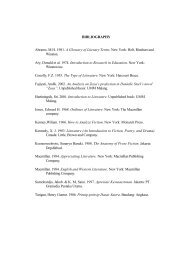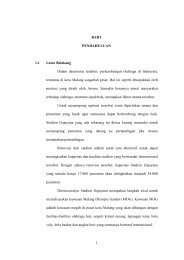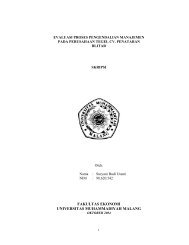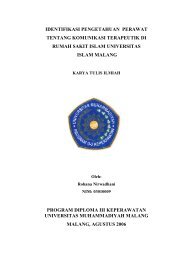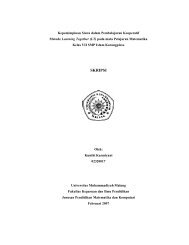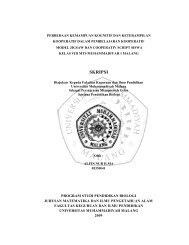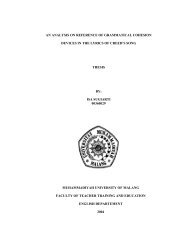File : THESIS.pdf - Universitas Muhammadiyah Malang
File : THESIS.pdf - Universitas Muhammadiyah Malang
File : THESIS.pdf - Universitas Muhammadiyah Malang
Create successful ePaper yourself
Turn your PDF publications into a flip-book with our unique Google optimized e-Paper software.
BIOLOGY 9700 A/AS LEVEL<br />
Candidates should be able to:<br />
(a) *carry out tests for reducing and non-reducing sugars (including semi-quantitative use<br />
of the Benedict’s test), the iodine in potassium iodide solution test for starch, the<br />
emulsion test for lipids and the biuret test for proteins;<br />
(b) describe the ring forms of alpha and beta glucose;<br />
(c) describe the formation and breakage of a glycosidic bond;<br />
(d) describe the molecular structure of starch (amylose and amylopectin),<br />
glycogen and cellulose and relate these structures to their functions in living<br />
organisms;<br />
(e) describe the molecular structure of a triglyceride and a phospholipid and relate<br />
these structures to their functions in living organisms;<br />
(f) describe the structure of an amino acid and the formation and breakage of a peptide<br />
bond;<br />
(g) explain the meaning of the terms primary structure, secondary structure, tertiary<br />
structure and quaternary structure of proteins and describe the types of bonding<br />
(hydrogen, ionic, disulphide and hydrophobic interactions) that hold the molecule in<br />
shape;<br />
(h) describe the molecular structure of haemoglobin as an example of a globular protein,<br />
and of collagen as an example of a fibrous protein and relate these structures to their<br />
functions (the importance of iron in the haemoglobin molecule should be<br />
emphasised);<br />
(i) describe and explain the roles of water in living organisms and as an<br />
environment for organisms;<br />
(j) state one role of each of the following inorganic ions in living organisms: calcium,<br />
sodium, potassium, magnesium, chloride, nitrate, phosphate;<br />
(k) use the knowledge gained in this section in new situations or to solve related problems.<br />
C ENZYMES<br />
Content<br />
Mode of action of enzymes<br />
Learning Outcomes<br />
Candidates should be able to:<br />
(a) explain that enzymes are globular proteinsthat catalyse metabolic reactions;<br />
(b) explain the mode of action of enzymes in terms of an active site, enzyme/substrate<br />
complex, lowering of activation energy and enzyme specificity;<br />
(c) *follow the time course of an enzyme-catalysed reaction by measuring rates of<br />
formation of products (for example, using catalase) or rates of disappearance of<br />
substrate (for example,using amylase);<br />
(d) *investigate and explain the effects of temperature, pH, enzyme concentration and<br />
substrate concentration on the rate of enzyme-catalysed reactions, and explain these<br />
effects;<br />
(e) explain the effects of competitive and non-competitive inhibitors on the rate of<br />
enzyme activity;<br />
(f) use the knowledge gained in this section in new situations or to solve related problems.<br />
D CELL MEMBRANES AND TRANSPORT<br />
Content<br />
The fluid mosaic model of membrane structure<br />
The movement of substances into and out of cells<br />
Learning Outcomes<br />
117



